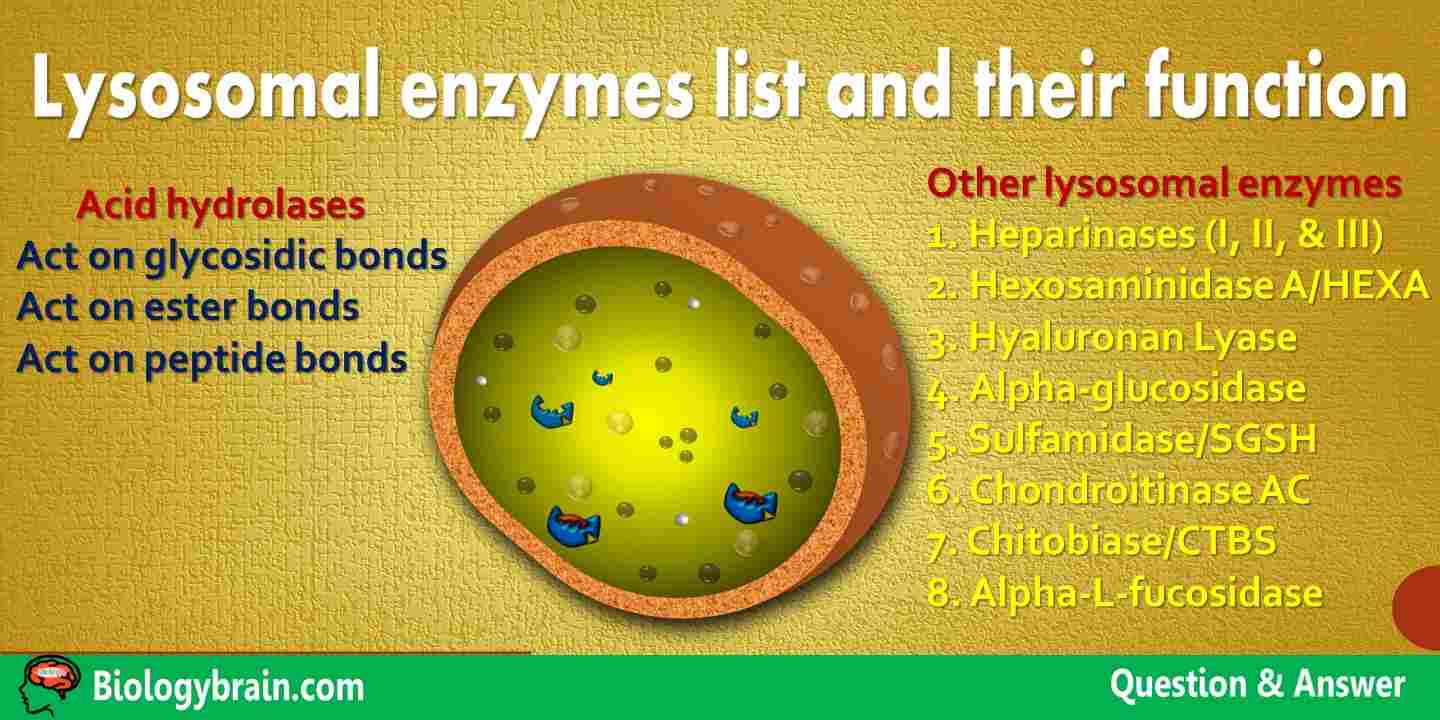Lysosomal enzymes: The enzymes that are found in lysosomes are called lysosomal enzymes. Lysosomal enzymes digest unwanted proteins, lipids, viral particles, nucleic acids, carbohydrates, and other materials that are taken up by the cells by a process called endocytosis.
However, based on their catalytic activity on different chemical bonds of substrate molecules, lysosomal enzymes, especially acid hydrolases, have been divided into three groups.

The lysosomal enzymes list
1. Acid hydrolases (act on glycosidic bonds)
2. Acid hydrolases (act on ester bonds)
3. Acid hydrolases (act on peptide bonds)
1. Acid hydrolases (act on glycosidic bonds)
- Glucosidase: This enzyme is involved in the digestion of complex carbohydrates such as glycogen and starch into their monomers. Glucosidase catalyzes the removal of individual glucosyl residues (monomers) from various glycoconjugates, including alpha- or beta-linked polymers of glucose. This enzyme converts complex sugars into simpler ones.
- Mannosidase: This lysosomal enzyme cleaves complex sugar molecules, especially mannose-containing oligosaccharides, which are attached to certain proteins (glycoproteins).
- Beta-galactosidase: This lysosomal enzyme, also called lactase, catalyzes the hydrolysis of β-galactosides into their monomers through the breaking of a glycosidic bond. (β-galactosides are carbohydrates, they contain galactose molecules in their structure, in which the glycosidic bond lies above the galactose molecule).
- Lysozyme: This is also called muramidase or N-acetylmuramide glycanhydrolase. In general, lysozyme is an antibacterial enzyme that catalyzes the cleavage of the bacterial cell walls, which contain N-acetylglucosamine and N-acetyl muramic acid.
2. Acid hydrolases (act on ester bonds)
- Phospholipase: This is a crucial enzyme of lysosomes that catalyzes the hydrolyzes of phospholipids into fatty acids and glycerol or other fatty substances. There are four main types of this enzyme, including A, B, C, and D, which are classified based on the type of enzymatic reaction that they carry out.
- Sphingomyelinase: This enzyme is also known as sphingomyelin phosphodiesterase, acid sphingomyelinase, or SMase) is a hydrolase enzyme, is very important in sphingolipid metabolism. Sphingomyelinase belongs to the DNase I superfamily of enzymes and that catalyzes the hydrolysis of sphingomyelin (SM) into phosphocholine and ceramide.
- Acid phosphatase: Acid phosphatase is also known as acid phosphomonoesterase, acid monophosphatase, acid phosphohydrolase, acid phosphomonoester hydrolase, acid nucleoside diphosphate phosphatase, phosphomonoesterase, glycerophosphatase, uteroferrin, and orthophosphoric-monoester phosphohydrolase. This enzyme catalyzes the hydrolases of organic phosphates into inorganic phosphates. They can use different substrates, which are bound by a phosphate group. Acid phosphatase is located in lysosomes and performs its functions when it fuses with endosomes. In general, it is acidified during its function; therefore, it should require an acidic environment. Interestingly, this enzyme can be found in many animal and plant species. During typical and pathological bone resorption, osteoclastic acid phosphatase is produced in bulk amounts by osteoclast cells. So far, they are also used as diagnostic markers to distinguish different types of cancers.
3. Acid hydrolases (act on peptide bonds)
- Cathepsins: Cathepsins are proteolytic enzymes of lysosomes found in all animals and other organisms. Based on the structural differences, rate of the catalytic mechanism, or specificity toward substrate protein, these enzymes have been divided into around twelve families. Most of these enzymes show potential activity in the low pH environment of the lysosomes. Thus, the activity of this family is found only within the lysosomes. However, there is an exception such as the cathepsin K, which catalyzes the proteins extracellularly after it is secreted by osteoclasts during bone resorption. Cathepsins have taken a major role in the turnover of mammalian cellular components.
- Carboxypeptidase: Carboxypeptidase is also a proteolytic enzyme that acts on peptide bond and cleaves it at the carboxy-terminal (C-terminal) end of the protein or peptide. Carboxypeptidases are found in both animals and plants. Different types of this enzyme are found in animal and plant cells and show diverse functions ranging from catabolism to protein modification.
Other lysosomal enzymes list
1. Heparinase enzymes (I, II, and III)
2. Hexosaminidase A/HEXA
3. Hyaluronan Lyase
4. Lysosomal alpha-glucosidase
5. Sulfamidase/SGSH
6. Chondroitinase AC
7. Chitobiase/CTBS
8. Alpha-L-fucosidase
9. and other enzymes
Note: A deficiency of any one of these lysosomal enzymes will result in the development of lysosomal storage disease.
Related topics:










